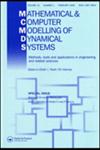维也纳舞厅的建模:基于主体的模拟研究复杂行为
IF 1.8
4区 数学
Q3 COMPUTER SCIENCE, INTERDISCIPLINARY APPLICATIONS
Mathematical and Computer Modelling of Dynamical Systems
Pub Date : 2020-02-19
DOI:10.1080/13873954.2020.1727930
引用次数: 1
摘要
摘要在历史悠久的大舞厅里跳维也纳圆舞曲是奥地利文化的重要组成部分。这种舞蹈虽然是传统舞蹈,但很难表演,尤其是在舞池拥挤的情况下。在那里,避免与其他舞者发生碰撞是一项额外的挑战,因为他们在舞厅中以高速踱步。根据舞者的技术水平,可以调整旋转速度以取得成功。本文提出了一个基于主体的华尔兹模型,该模型使研究不同技术的舞者对舞蹈人群动作流畅性的影响成为可能。在这里,每个代理在现实中代表一对跳舞的情侣,并且它通过周期性地切换旋转轴的旋转运动在舞池中移动。主体之间的相互作用通过非弹性碰撞发生。通过进行几个案例研究,我们分析并量化了广泛流传的谣言,即只有少数不熟练的舞者扰乱了跳舞人群的流动。本文章由计算机程序翻译,如有差异,请以英文原文为准。
Modelling a Viennese ballroom: agent-based simulation to investigate complex behaviour
ABSTRACT Dancing Viennese Waltz in one of the great historic ballrooms is an important and indispensable part of Austrian culture. This dance, while being tradition, is quite difficult to perform, especially if the dance-floor is crowded. There, it is additionally challenging to avoid collisions with other dancers, as they pace through the ballroom at a high velocity. Dependent on the dancer’s skill level, spinning speed can be adjusted to succeed. This paper presents an agent-based waltz model which makes it possible to investigate the influence of heterogeneously skilled dancers on the movement smoothness of the dancing crowd. Herein, each agent represents one dancing couple in reality and it moves on the dance-floor by a rotatory motion with periodically switching rotation axes. Interaction between agents occurs via inelastic collisions. By performing a couple of case studies, we analyse and quantify the widespread rumour that the presence of only a few unskilled dancers disturbs the flow of the dancing crowd.
求助全文
通过发布文献求助,成功后即可免费获取论文全文。
去求助
来源期刊
CiteScore
3.80
自引率
5.30%
发文量
7
审稿时长
>12 weeks
期刊介绍:
Mathematical and Computer Modelling of Dynamical Systems (MCMDS) publishes high quality international research that presents new ideas and approaches in the derivation, simplification, and validation of models and sub-models of relevance to complex (real-world) dynamical systems.
The journal brings together engineers and scientists working in different areas of application and/or theory where researchers can learn about recent developments across engineering, environmental systems, and biotechnology amongst other fields. As MCMDS covers a wide range of application areas, papers aim to be accessible to readers who are not necessarily experts in the specific area of application.
MCMDS welcomes original articles on a range of topics including:
-methods of modelling and simulation-
automation of modelling-
qualitative and modular modelling-
data-based and learning-based modelling-
uncertainties and the effects of modelling errors on system performance-
application of modelling to complex real-world systems.

 求助内容:
求助内容: 应助结果提醒方式:
应助结果提醒方式:


